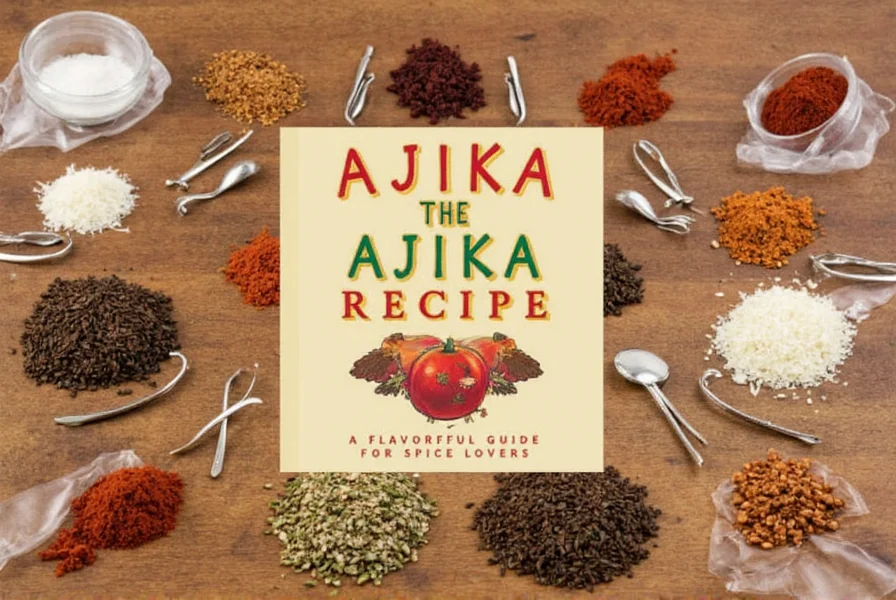Table of Contents
Introduction to Ajika
Ajika is a traditional spice blend originating from the Caucasus region, particularly Georgia, Armenia, and Azerbaijan. Known for its bold, smoky, and slightly spicy flavor profile, it typically contains red peppers, garlic, coriander, cumin, and other aromatic spices. This guide covers everything you need to know about ajika, from its origins to practical cooking applications and buying tips.
What is Ajika?
Ajika is a traditional spice blend that originates from the Caucasus region, particularly Georgia, Armenia, and Azerbaijan. It's known for its bold, smoky, and slightly spicy flavor profile. The name 'ajika' comes from the Georgian word for 'pepper,' and it typically contains a mix of red peppers, garlic, coriander, cumin, and other aromatic spices.
The key components of ajika include:
- Red Peppers – provide the base heat and color.
- Garlic – adds depth and umami.
- Coriander – contributes a citrusy, earthy note.
- Cumin – brings warmth and complexity.
- Other Spices – depending on the recipe, it might also include paprika, black pepper, or even dried herbs like thyme or oregano.
Types of Ajika
Ajika isn't a one-size-fits-all spice. There are several variations, each with its own unique flavor profile and regional influence. Here are the most common types:
1. Traditional Ajika
This is the classic version, often made by grinding red peppers, garlic, and spices into a paste or powder. It's commonly used in soups, stews, and meat dishes.
2. Smoked Ajika
Some recipes incorporate smoked peppers or add a smoky flavor through roasting or smoking techniques. This gives the ajika a more intense, rich taste.
3. Modern or Commercial Ajika
Many brands now sell pre-made ajika blends, making it easier for home cooks to experiment. These versions may vary in spice level and flavor, so always check the label before purchasing.
How to Use Ajika
Ajika is incredibly versatile and can be used in a variety of ways. Whether you're grilling, roasting, or simmering, this spice blend adds a punch of flavor that's hard to resist. Here are some popular uses:
1. In Soups and Stews
Add a spoonful of ajika to your favorite soup or stew for an extra layer of heat and flavor. It works especially well in tomato-based dishes or lentil soups.
2. As a Marinade
Mix ajika with olive oil, lemon juice, and garlic to create a marinade for chicken, lamb, or vegetables. Let it sit for at least 30 minutes before cooking.
3. On Grilled Meats
Use ajika as a rub for grilled meats. It pairs perfectly with kebabs, grilled fish, or roasted veggies.
4. In Dips and Sauces
Combine ajika with yogurt or sour cream to make a creamy dip or sauce. It's great with pita bread, chips, or as a side to grilled meats.
Practical Tips for Using Ajika
Whether you're new to ajika or a seasoned user, here are some tips to help you get the most out of this incredible spice:
- Start Small: Ajika can be quite strong, so it's best to start with a small amount and adjust to taste.
- Experiment with Pairings: Try mixing ajika with other spices like paprika, chili flakes, or even curry powder for a unique twist.
- Store Properly: Keep ajika in an airtight container away from direct sunlight to maintain its freshness and potency.
- Make Your Own: If you have access to fresh peppers and spices, consider making your own ajika for a personalized flavor.
- Use in Baking: Believe it or not, ajika can be used in baked goods too! Try adding a pinch to bread or cookies for a surprising kick.
Frequently Asked Questions
What is the quickest way to use ajika for bold flavors in 10 minutes or less?
The fastest way to experience ajika's bold flavors is to mix 1 teaspoon of ajika with 2 tablespoons of olive oil and a squeeze of lemon juice. Use this as a finishing sauce for grilled meats, roasted vegetables, or even stirred into soups just before serving. This takes less than 5 minutes and instantly elevates the dish with complex, smoky flavors.
How spicy is ajika, and can I adjust the heat level?
Ajika's spiciness varies by recipe and region. Traditional Georgian ajika ranges from mild to moderately spicy, but commercial versions can be hotter. The beauty of ajika is that you can easily control the heat - start with 1/4 to 1/2 teaspoon per serving and adjust to your taste. Remember, a little goes a long way with this potent spice blend.
Can I make authentic ajika at home without specialized equipment?
Absolutely! You don't need special equipment to make great ajika. For a quick homemade version: toast 1 teaspoon each of coriander and cumin seeds in a dry pan, grind them, then mix with 1 teaspoon paprika, 1/2 teaspoon garlic powder, a pinch of salt, and a few drops of smoked paprika liquid (or regular paprika). This 5-minute version captures the essential flavors, though traditional recipes use fresh peppers and take longer.
How is ajika different from harissa or other chili pastes?
While both are spicy condiments, ajika stands out with its distinctive blend of coriander and cumin, giving it a more complex, earthy flavor profile compared to harissa's caraway and rose notes. Ajika typically has a brighter, more citrusy quality and often includes more dried herbs. It's generally less oily than many chili pastes and has a unique balance of heat, earthiness, and subtle sweetness.
What are the main health benefits of using ajika in cooking?
Ajika offers several health benefits thanks to its key ingredients: the capsaicin in peppers may boost metabolism and reduce inflammation, garlic provides immune-supporting compounds, and cumin aids digestion. As a salt-free seasoning option, it's great for reducing sodium in your diet while still adding bold flavor. Just be mindful of commercial versions that might contain added oils or preservatives.
Buying Guide for Ajika
When shopping for ajika, it's important to know what to look for. Here's a detailed buying guide to help you choose the right product:
| Product Name | Features | Advantages | Use Cases | Target Audience | Suitable Occasions |
|---|---|---|---|---|---|
| Traditional Georgian Ajika | Handmade from red peppers, garlic, coriander, and cumin | Authentic flavor, no artificial additives | Grilled meats, soups, stews | Home cooks, spice enthusiasts | Family dinners, cultural events |
| Smoked Ajika Blend | Includes smoked peppers and spices | Rich, complex flavor with a smoky finish | Roasted vegetables, grilled dishes | Chefs, adventurous cooks | BBQ parties, gourmet meals |
| Commercial Ajika Mix | Pre-mixed, ready-to-use blend | Convenient, consistent quality | Dips, sauces, seasoning for any dish | Busy professionals, casual cooks | Potlucks, quick meals |
One of the key features of ajika is its ability to enhance the flavor of any dish without overpowering it. It's a perfect example of how a simple spice blend can elevate a meal to something truly special.

Conclusion
Ajika is more than just a spice—it's a gateway to a world of flavor and tradition. From its roots in the Caucasus to its modern-day popularity around the globe, this spice blend has something to offer every cook, whether they're a beginner or a pro. With the right techniques and a little creativity, you can bring the bold, smoky, and spicy flavors of ajika into your kitchen.
So next time you're looking to spice up your meal, don't forget about ajika. It's a simple yet powerful addition that can transform your cooking in ways you never thought possible. Happy cooking!











 浙公网安备
33010002000092号
浙公网安备
33010002000092号 浙B2-20120091-4
浙B2-20120091-4